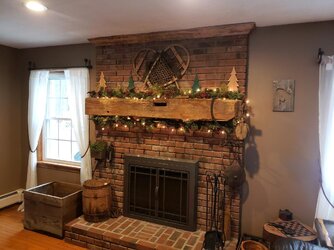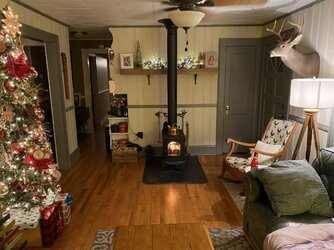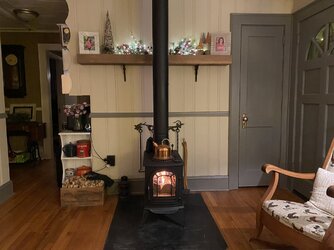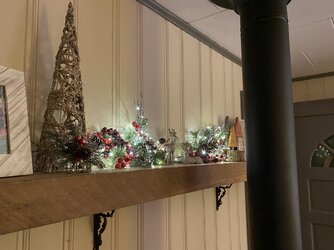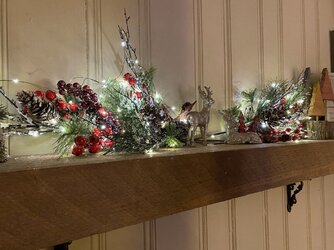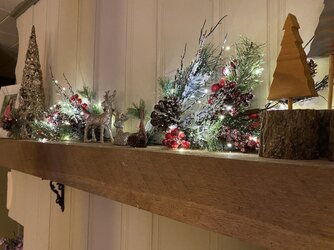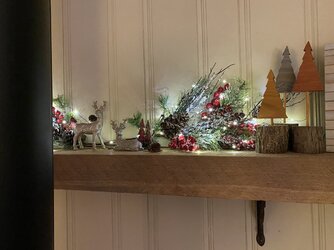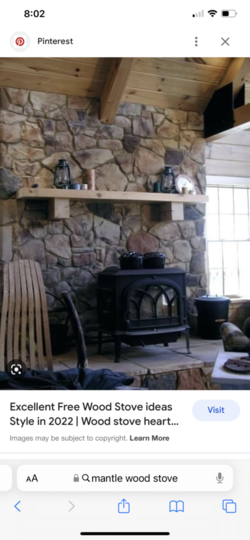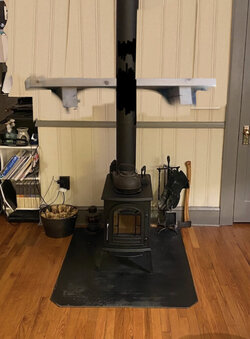Anyone made their own mantle? I want to find a barn timber or just save a chunk out of the next tree I cut. Are the old barn wood treatments from 100 years ago bad to have above the stove?
Timber mantle
- Thread starter 30WCF
- Start date
-
Active since 1995, Hearth.com is THE place on the internet for free information and advice about wood stoves, pellet stoves and other energy saving equipment.
We strive to provide opinions, articles, discussions and history related to Hearth Products and in a more general sense, energy issues.
We promote the EFFICIENT, RESPONSIBLE, CLEAN and SAFE use of all fuels, whether renewable or fossil.
You are using an out of date browser. It may not display this or other websites correctly.
You should upgrade or use an alternative browser.
You should upgrade or use an alternative browser.
As long as you meet all clearance requirements it's perfectly fine. I have made many from rustic ones to very decorative to clean lined modern onesAnyone made their own mantle? I want to find a barn timber or just save a chunk out of the next tree I cut. Are the old barn wood treatments from 100 years ago bad to have above the stove?
I was just worried about what they may have been covered with or treated with. I’ve heard of them painting barns with used motor oil and such to preserve them.
I cut a nice timber out of a downed cherry tree in early 2020 for a kid (30'ish) building a big beautiful house. He wanted a locally grown mantle for his living room so I borrowed my buddy's big Husky saw with a 36" bar and used his Alaska mill to cut about an 8 foot 6" x 9" piece for him since he gave me all the downed black locust I could pull out of the build site before the backhoe came in and dug the basement. He put it into his brother-in-law's basement next door to dry and when I was over there fall 2021 he hadn't mounted it yet. Haven't been back to check on it, but intend to soon, and also to see if he has any more downed trees  Should be a beautiful piece once he gets it done.
Should be a beautiful piece once he gets it done.
 Should be a beautiful piece once he gets it done.
Should be a beautiful piece once he gets it done.Ashful
Minister of Fire
Probably more an issue down where you live, due to the propensity of termites and other wood borers, than up north. I have owned and rebuild several old barns, and I've not come across any such thing.I was just worried about what they may have been covered with or treated with. I’ve heard of them painting barns with used motor oil and such to preserve them.
Both of my fireplace lintels are made from 10 x 10 inch x 7 ft. timbers, and one of my fireplaces (see avatar) has a second timber in the face, to which the mantel facia was nailed. But old houses generally didn't use rough unfinished timber for the mantel itself, that stuff was all meant to be hidden behind a proper finished mantel and plaster.
If I were wanting a timber mantel, though, I wouldn't look for posts and beams. 6" is visually too thick for a mantel. Old floor joists, generally measuring 2 or 3 inches thick by 6 or 8 inches wide, would probably make a nicer looking mantel than a heavy and clunky 6 x 6 timber. Many of these have decorative beading on both corners of one edge, meant to dress up exposed joists a little on 18th century houses, where the second floor was often left without a ceiling.
I found an oak 4”x10” rough cut. That a guy has leftover from when he built his house and mantle 25 years ago. I’m going to grab later this week.
I have seen more than a few attempts using recently cut wood that ended up in the long run with cracking and warping issues. Even air drying for a year is not going to make that much of difference in eventual warping and checking. It really needs kiln drying by someone who knows what they are doing. I remember one white pine mantle made with very tight grain wood that seemed to be a fountain of sap for several years. I also saw a few Red Oak mantels that had significant twist. A mantle is tough place as the radiant heat from the stove is landing on one side while the other receives far less. This sets up a difference in moisture content until it eventually dries out and that can introduce warping.
Ideally you need to find old wood that has reached equilibrium moisture content and then cycled through multiple seasonal effects.
As for surface treatments toxicity, anything is possible. Wood exposed to the sun will bake out most treatments but the only way to know if there is toxic stuff on the wood is to have it tested. If it was painted, its likely that there could have been lead paint and some paints had mercury in them. The option would be to saw off the surfaces but that would take away the aged look.
Ideally you need to find old wood that has reached equilibrium moisture content and then cycled through multiple seasonal effects.
As for surface treatments toxicity, anything is possible. Wood exposed to the sun will bake out most treatments but the only way to know if there is toxic stuff on the wood is to have it tested. If it was painted, its likely that there could have been lead paint and some paints had mercury in them. The option would be to saw off the surfaces but that would take away the aged look.
Ashful
Minister of Fire
Ideal. Hopefully dry and stable, by now!I found an oak 4”x10” rough cut. That a guy has leftover from when he built his house and mantle 25 years ago. I’m going to grab later this week.
BTW, KD red oak is available in this size, at least around here. I've never found a good source for KD'd white oak timber, though. I think it's just too costly to effectively kiln that stuff in any great thickness.
25 years should get it dry if it’s been stored remotely well, I would think.Ideal. Hopefully dry and stable, by now!
BTW, KD red oak is available in this size, at least around here. I've never found a good source for KD'd white oak timber, though. I think it's just too costly to effectively kiln that stuff in any great thickness.
stoveliker
Minister of Fire
That would depend on where it was stored. Inside or outside. The equilibrium moisture content for most north east is about 13-14 pct if I remember correctly. And in your home it might be half of that.
stoveliker
Minister of Fire
Yes, that table in a different form is what I know. So what is the average humidity in your home? And when the stove is going (under that mantel)? And what do you need that mantel moisture content to be for it not to warp? I don't know. Maybe all is good. Maybe not. Someone else might be able to tell you.
The short form version of kiln drying wood for furniture is the bring the moisture content of the wood down below the lowest possible moisture content that the wood will see in use. There are "schedules" of drying for specific species used to make sure its not dried too quickly which may include bringing the moisture content up slowly and then reducing it. Grain spacing alignment and ring size also makes a difference. There also can be stresses built up in the wood by growing conditions. Different species of wood have open or closed grain that also factors in. I had a red oak stereo rack I built in college with a flat top. Despite alternating the grain and sealing the wood, it would curve upwards in the late fall and winter in the dry dorm and then flatten out in the spring as the humidity went up, it was kiln dried wood. Ash acts similarly. Maple, far less. Ideally if the mantle is cut from the center of a straight tree so that the pith is in the middle of the mantle the grain stress is equal and even if it expands and contracts it stays straight and flat. If on the other handle its offset from the center of the pith, its going to curve especially with uneven heating. Old growth with tight rings is usually going to be more stable than second growth managed to grow quickly. If the grain is complex witrh lots of "figure" its probably going to react strangely to moisture content variation.
It comes down to, a solid piece of wood came from a living tree that is going to react to changes in temperature and humidity, there are ways to minimize it but if you want a flat stable mantle, buy plywood, steel or Corian.
It comes down to, a solid piece of wood came from a living tree that is going to react to changes in temperature and humidity, there are ways to minimize it but if you want a flat stable mantle, buy plywood, steel or Corian.
Ashful
Minister of Fire
Great post, peakbagger. I'd just add to it that quarter sawn can also be stable with regard to cupping, no need to center cut on the pith (which has other issues). Long story short, wood's dimensional response to moisture is tangential to growth rings, which is why flat-sawn boards vary mostly in width and quarter-sawn vary almost exclusively in thickness, as well as the reason flat-sawn boards cup more than other milled orientations.
The direction of cupping depends on the moisture content of the wood today, versus when it was milled. As peakbagger noted, commercial lumber is generally roughed, then dried to beyond anything it will see in use (often close to 8% MC), before finish milling. So, commercial lumber will generally cup in a direction that makes the growth rings curl to an even tighter radius, as the lumber re-absorbs atmospheric moisture and expands tangentially along the growth rings.
This is why air-dried lumber is coveted by furniture makers, and also a good reason to buy your KD'd lumber rough and let it acclimate many months in your home/shop, if you're an amateur furniture maker. If you finish mill it at some humidity level near the average it will assume in your home, even regular flat-sawn lumber can be tamed, to some degree.
What's all this have to do with a rustic rough-sawn mantel? Nothing. The OP wants it rough and rustic... let it warp!
The direction of cupping depends on the moisture content of the wood today, versus when it was milled. As peakbagger noted, commercial lumber is generally roughed, then dried to beyond anything it will see in use (often close to 8% MC), before finish milling. So, commercial lumber will generally cup in a direction that makes the growth rings curl to an even tighter radius, as the lumber re-absorbs atmospheric moisture and expands tangentially along the growth rings.
This is why air-dried lumber is coveted by furniture makers, and also a good reason to buy your KD'd lumber rough and let it acclimate many months in your home/shop, if you're an amateur furniture maker. If you finish mill it at some humidity level near the average it will assume in your home, even regular flat-sawn lumber can be tamed, to some degree.
What's all this have to do with a rustic rough-sawn mantel? Nothing. The OP wants it rough and rustic... let it warp!
Sean McGillicuddy
Minister of Fire
sloeffle
Minister of Fire
I agree, great post @peakbagger
I use to build custom furniture and as part of my schooling I learned about drying lumber. As others have elluded to you could have the wood kiln dried but I would make sure that whoever does it for you really knows what they are doing. I wouldn't kiln dry it until it has been air dried a number of years. When I built furniture, I've cut into more than one 12/4 or 16/4 piece of wood that was honeycombed. That happens because they try to dry the wood too fast and the wood essentially comes apart on the inside. The only thing that wood is good for at that point is firewood. If you want to learn about drying wood or wood in general, I'd highly recommend this book.
A friend of mine from school builds some very beautiful high end furniture and mills all of his own lumber so avoid some of the pitfalls that have been talked about when buying from a mill. He's in @Ashful neighborhood I believe.
Don't believe the hype around using biscuits or any of that BS when edge gluing boards. The glue itself is stronger than the wood. When we would glue boards up we selected the best pattern match.
I use to build custom furniture and as part of my schooling I learned about drying lumber. As others have elluded to you could have the wood kiln dried but I would make sure that whoever does it for you really knows what they are doing. I wouldn't kiln dry it until it has been air dried a number of years. When I built furniture, I've cut into more than one 12/4 or 16/4 piece of wood that was honeycombed. That happens because they try to dry the wood too fast and the wood essentially comes apart on the inside. The only thing that wood is good for at that point is firewood. If you want to learn about drying wood or wood in general, I'd highly recommend this book.
A friend of mine from school builds some very beautiful high end furniture and mills all of his own lumber so avoid some of the pitfalls that have been talked about when buying from a mill. He's in @Ashful neighborhood I believe.
Don't believe the hype around using biscuits or any of that BS when edge gluing boards. The glue itself is stronger than the wood. When we would glue boards up we selected the best pattern match.
I’llm enjoying the content so keep it coming, but I don’t think a little checking or wiggle is going to bother me for what I intend.
I cut a big cedar out of my yard a couple years ago just like that for the same purpose. Now I wish it was longer, so I’m going a different direction.Like this
View attachment 304070
Ashful
Minister of Fire
Last edited:
Ashful
Minister of Fire
Similar threads
- Replies
- 1
- Views
- 265
- Replies
- 1
- Views
- 952
- Replies
- 11
- Views
- 534
- Replies
- 23
- Views
- 4K



